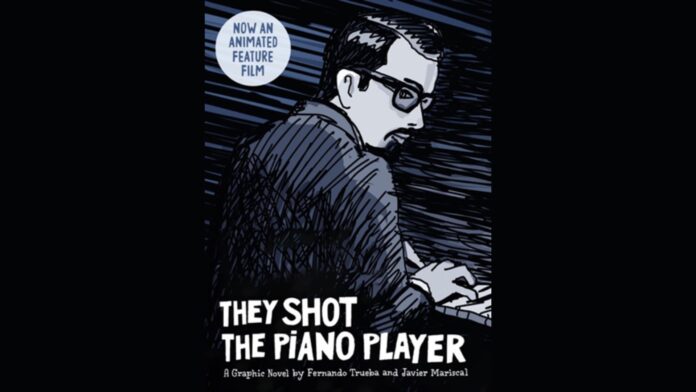Director Fernando Trueba’s career has been steeped in music. His first narrative films, Ópera Prima (1980) and Sal Gorda (1983), had musicians for protagonists. All his documentaries, too, from Mientras el Cuerpo Aguante (1982) to El Milagro de Candeal (2004) have revolved around music or artists like Chucho Vales and Michel Camilo. More recently even, after a hiatus from his favourite subject, the director returned to music with Chico and Rita (2010). All of which should make Trueba’s latest project, They Shot the Piano Player, a surprise to no one.
The graphic novel, adapted from his film of the same name, follows music journalist Jeff Harris’s research into the bossa nova movement. But his discovery of pianist Tenório Júnior on the eve of his departure to Rio changes everything. From the moment he arrives at Ipanema Beach, the pianist’s name resurfaces, and though it seems to be a known quantity in Brazil, no one knows what happened to him. Tenório simply left his hotel one night while on tour in Buenos Aires never to be seen again. Determined to uncover the truth, Harris’s investigations take him from Rio to rural Brazil, all the way to the Argentine capital.
Like many of Trueba’s previous projects, They Shot the Piano Player shines a light on a generally overlooked subject matter, and that forms part of its appeal. A documentary about Tenório was shot by Brazilian filmmaker Rogerio Lima in 1976 and reworked in 1986 and 1996, but it failed to present a complete picture due to its proximity to events, while its local nature meant that it spoke to a local audience. Moreover, Tenório’s disappearance was overshadowed by the context in which he disappeared: for all his talent, Tenório was but one of some 30,000 presumed missing from the National Reorganisation Process years. They Shot the Piano Player – through its graphic and narrative nature – makes Tenório’s story available to the wider public.
Though the story focuses on Tenório’s disappearance, it also memorialises the magic of the 1960s and 1970s. Its semi-fictional, semi-documentary style, allows the story to jump in time and space, providing context to the memories of Harris’s interviewees. In one memorable passage, Brazilian club owner Alberico Campana recalls Ella Fitzgerald’s impact on the local music scene, and we are treated to a flashback of the singer’s 1962 concert at Copacabana Palace. In the imagined aftermath of her concert, and under cover of night, she is depicted going to Beco das Garrafas, the barrio where bossa nova was being born, and scatting to the Tamba Trio. It equally vivifies the darker side of those decades through its graphic depiction of events, allowing readers to appreciate the political instability that reigned supreme through large pockets of South America.
This sense of time and place is cemented by the artistry that illustrator Javier Mariscal brings to the graphic novel. Each location in the novel has its own colour palette and style, and these chromatic shifts provide the mood for the novel. A flashback of the Rio carnival brings an explosion of colour to the page while an interviewee’s sombre memory turns it monochromatic. Each decade is also adorned with subtle nods to its cultural context. In the Argentine capital, an advertisement for band Fito & Fitipaldis behind the Obelisco hints to the band’s peak years, while Nazi memorabilia in the basement of the Brazilian embassy some time in the 1970s hints at the exodus of Nazis to South America post WWII. These details – mostly musical in nature – flesh out the cultural context of the times.
As a whole, They Shot the Piano Player is a graphic novel to rival Maus or Persepolis. Its story is a reminder of recent history which, though only half a century old, seems very yesteryear. Bossa nova and jazz have been replaced by the harmonious rhythms of techno music while the genocide of the 1970s has gone out of the news and into the history textbooks, but the scars and the scatting remain recent memory.
Words by Elkyn Ernst
